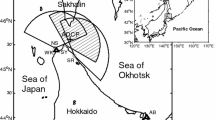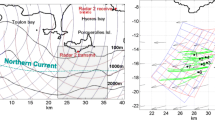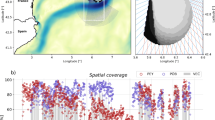Abstract
The rapid expansion of urbanization along the world’s coastal areas requires a more comprehensive and accurate understanding of the coastal ocean. Over the past several decades, numerical ocean circulation models have tried to provide such insight, based on our developing understanding of physical ocean processes. The systematic establishment of coastal ocean observation systems adopting cutting-edge technology, such as high frequency (HF) radar, satellite sensing, and gliders, has put such ocean model predictions to the test, by providing comprehensive observational datasets for the validation of numerical model forecasts. The New York Harbor Observing and Prediction System (NYHOPS) is a comprehensive system for understanding coastal ocean processes on the continental shelf waters of New York and New Jersey. To increase confidence in the system’s ocean circulation predictions in that area, a detailed validation exercise was carried out using HF radar and Lagrangian drifter-derived surface currents from three drifters obtained between March and October 2010. During that period, the root mean square (RMS) differences of both the east–west and north–south currents between NYHOPS and HF radar were approximately 15 cm s−1. Harmonic analysis of NYHOPS and HF radar surface currents shows similar tidal ellipse parameters for the dominant M2 tide, with a mean difference of 2.4 cm s−1 in the semi-major axis and 1.4 cm s−1 in the semi-minor axis and 3° in orientation and 10° in phase. Surface currents derived independently from drifters along their trajectories showed that NYHOPS and HF radar yielded similarly accurate results. RMS errors when compared to currents derived along the trajectory of the three drifters were approximately 10 cm s−1. Overall, the analysis suggests that NYHOPS and HF radar had similar skill in estimating the currents over the continental shelf waters of the Middle Atlantic Bight during this time period. An ensemble-based set of particle tracking simulations using one drifter which was tracked for 11 days showed that the ensemble mean separation generally increases with time in a linear fashion. The separation distance is not dominated by high frequency or short spatial scale wavelengths suggesting that both the NYHOPS and HF radar currents are representing tidal and inertial time scales correctly and resolving some of the smaller scale eddies. The growing ensemble mean separation distance is dominated by errors in the mean flow causing the drifters to slowly diverge from their observed positions. The separation distance for both HF radar and NYHOPS stays below 30 km after 5 days, and the two technologies have similar tracking skill at the 95 % level. For comparison, the ensemble mean distance of a drifter from its initial release location (persistence assumption) is estimated to be greater than 70 km in 5 days.








Similar content being viewed by others
References
Barrick DE, Evans MW, Weber BL (1977) Ocean surface currents mapped by radar. Science 198:138–144
Beardsley RC, Boicourt WC (1981) On estuarine and continental-shelf circulation in the Middle Atlantic Bight. In: Warren BA, Wunsch C (eds) Evolution of physical oceanography. MIT, Cambridge, pp 198–233
Beegle-Krause CJ (2001) General NOAA Oil Modeling Environment (GNOME): a new spill trajectory model. IOSC 2001 Proceedings, 2:865–871
Bhushan S, Blumberg AF, Georgas N (2009) Comparison of NYHOPS hydrodynamic model SST predictions with satellite observations in the Hudson River tidal, estuarine, and coastal plume region. 11th International Conference in Estuarine and Coastal Modeling (ECM11). Spalding, M. L., Ph.D., P.E., American Society of Civil Engineers, Washington, pp 11–26
Blumberg AF, Galperin B (1990) On the summer circulation in New York Bight and contiguous estuarine waters. In: Cheng RT (ed) Residual currents and long-term transport, vol 38. Springer, New York, pp 451–468
Dzwonkowski B (2009) Surface current analysis of shelf water in the Central Mid-Atlantic Bight. University of Delaware, Delaware
Bruno M, Blumberg A, Herrington T (2006) The urban ocean observatory—coastal ocean observations and forecasting in the New York Bight. J Mar Sci Environ C4:1–9
Castellari S, Griffa A, Ozgokmen TM, Poulain PM (2009) Prediction of particle trajectories in the Adriatic Sea using Lagrangian data assimilation. J Mar Syst 29:33–50
Chang GC, Dickey TD, Schofield OM, Weidemann AD, Boss E, Pegau WS, Moline MA, Glenn SM (2002) Nearshore physical processes and bio-optical properties in the New York Bight. J Geophys Res 107(C9):3133–3149
Chant RJ, Glenn SM, Hunter E, Kohut J, Chen RF, Houghton RW, Bosch J, Schofield O (2008) Bulge formation of a buoyant river outflow. J Geophys Res 113:C01017. doi:10.1029/2007JC004100
Davis RE (1985) Drifter observations of coastal surface currents during CODE: the method and descriptive view. J Geophys Res 90:4741–4755
Di Liberto TE, Cole BA, Georgas N, Blumberg AF, Taylor AA (2011) Verification of multiple storm surge models and ensembles for the New York City metropolitan region. Weather Forecast 26:922–939
Dugan JP, Piotrowski CC (2003) Surface current measurement using visible image time series. Remote Sens Environ 1:309–319
Fan S, Oey LY, Hamilton P (2004) Assimilation of drifter and satellite data in a model of the Northeastern Gulf of Mexico. Cont Shelf Res 24:1001–1013
Fan SA, Blumberg AF, Bruno MS, Kruger D, Fullerton B (2006) The skill of an urban ocean forecast system. 9th International Conference in Estuarine and Coastal Modeling (ECM9). Spalding, M. L., Ph.D., P.E., American Society of Civil Engineers, South Carolina, pp 603–618
Flagg CN (1977) The kinematics and dynamics of the New England continental shelf and shelf/slope. Ph.D. thesis, MIT-WHOI Joint Program in Oceanography, Massachusetts
Frantantoni DM (2001) North Atlantic surface circulation during the 1990s’ observed with satellite-tracked drifters. J Geophys Res 106(C10):22067–22093
Gay PS, O’Donnell J, Edwards CA (2004) Exchange between Long Island Sound and adjacent waters. J Geophys Res 109:C06017. doi:10.1029/2004JC002319
Georgas, N. (2010) Establishing confidence in marine forecast systems: the design of a high fidelity marine forecast model for the NY/NJ harbor estuary and its adjoining waters. Dissertation, Stevens Institute of Technology
Georgas N (2012) Large seasonal modulation due to ice cover friction in a mid-latitude estuary. J Phys Oceanogr 42:352–369
Georgas N, AF Blumberg (2008) The New York Bight Shelf–Harbor dynamic study: ocean forecast sensitivity to forecasts of atmospheric forcing. Office of Naval Research, Arlington, 50 pp
Georgas N, Blumberg AF, Bruno MS, Runnels DS (2009) Marine forecasting for the New york urban waters and harbor approaches: the design and automation of NYHOPS. 3rd International Conference on Experiments / Process / System Modelling / Simulation & Optimization. Demos T. Tsahalis, Ph.D., University of Patras, Greece, 1:345–352 July 11 2009
Georgas N, Blumberg AF (2010) Establishing confidence in marine forecast systems: the design and skill assessment of the New York Harbor Observation and Prediction System, version 3 (NYHOPS v3). 11th International Conference in Estuarine and Coastal Modeling (ECM11). Spalding, M. L., Ph.D., P.E., American Society of Civil Engineers, Washington, pp 660–685
Georgas N, Blumberg AF, Herrington TO (2007) An operational coastal wave forecasting model for New Jersey and Long Island Waters. Reinhard E. Flick, Ph.D. Shore & Beach. American Shore and Beach Preservation Association. 75(2):30-35
Gopalakrishnan G, Blumberg AF (2012) Sensitivity of first-order Doppler region settings in the HF radar. Journal of Oceanography. J Oper Oceanogr. 5(1):75–87
Gong D, Kohut JT, Glenn SM (2010) Seasonal climatology of wind-driven circulation on the New Jersey Shelf. J Geophys Res 115:C4
Graber HC, Haus BK, Shay LK, Chapman RD (1997) HF radar comparisons with moored estimates of current speed and direction: expected differences and implications. J Geophys Res 102:18,749–18,766
Grant WD, Madsen OS (1979) Combined wave and current interactions with a rough bottom. J Geophys Res 84:1797–1808
Gurgel KW, Dzvonkovskaya A, Pohlmann T, Schlick T, Gill E (2011) Simulation and detection of tsunami signatures in ocean surface currents measured by HF radar. Ocean Dynamics. Springer Berlin, Heidelberg, pp 1–13
Kohut JT, Roarty HJ, Glenn SM (2006) Characterizing observed environmental variability with HF Doppler radar surface current mappers and acoustic Doppler current profilers: environmental variability in the coastal ocean. IEEE J Ocean Eng 31(4):876–884
Lentz SJ (2008a) Observations and a model of the mean circulation over the Middle Atlantic Bight continental shelf. J Phys Oceanogr 38:1203–1221
Lentz SJ (2008b) Seasonal variations in the circulation over the Middle Atlantic Bight continental shelf. J Phys Oceanogr 38:1486–1500
Lipa B, Barrick D (1983) Least-squares methods for the extraction of surface currents from CODAR crossed-loop data: application at ARSLOE. IEEE J Ocean Eng 8(4):226–253
Lipa B, Nyden B, Barrick D, Kohut J (2008) HF radar sea-echo from shallow water. Sensors 8:4582–4599. doi:10.3390/s8084582
Moody JA, Butman B, Beardsley RC, Brown WS, Daifuku P, Irish JD, Mayer DA, Mofield HO, Petrie B, Ramp S, Smith P, Wright WR (1984) Atlas of tidal elevation and current observations on the northeast American continental shelf and slope. US Geol Surv Bull 1611:122
U.S. National Academies (2010) Pathways to urban sustainability: research and development on urban systems—summary of a workshop. The National Academies Press, Washington
NOAA (2003) NOS standard for evaluating operational nowcast and forecast hydrodynamic model systems. http://www.nauticalcharts.noaa.gov/csdl/docs/RD_standards_Hess_etal.pdf
Noble M, Butman B, Williams E (1983) On the longshelf structure and dynamics of subtidal currents on the Eastern United States continental shelf. J Phys Oceanogr 13:2125–2147
North EW, King DM et al (2010) Linking optimization and ecological models in a decision support tool for oyster restoration and management. Ecol Appl 20(3):851–866
Paduan JD, Graber HC (1997) Introduction to high-frequency radar: reality and myth. Oceanography 10(2):36–39
Paduan JD, Rosenfeld LK (1996) Remotely sensed surface currents in Monterey Bay from shore-based HF radar (CODAR). J Geophys Res 101(C9):20,669–20,686
Parks AB, Shay LK et al (2009) HF radar observations of small-scale surface current variability in the Straits of Florida. J Geophys Res 114:C08002. doi:10.1029/2008JC005025
Poulain PM (2001) Adriatic Sea surface circulation as derived from drifter data between 1990 and 1999. J Mar Syst 29:3–32
Pawlowicz R, Beardsley R, Lentz S (2002) Classical tidal harmonic analysis including error estimates in MATLAB using T_TIDE. Comput & Geosci 28:929–937
Rasmussen LL, Gawarkiewicz G, Owens WB (2005) Slope water, gulf stream, and seasonal influences on the southern Mid-Atlantic Bight circulation during the fall–winter transition. J Geophys Res 110. doi:10.1029/2004JC002311
Roarty H, Glenn S, Kohut J, Gong D et al (2010) Operation and application of a regional HF radar network in the Mid-Atlantic Bight. Mar Technol Soc 44(6):185–195
Rudnick DL, Davis RE, Eriksen CC, Fratantoni DM, Perry M (2004) Underwater gliders for ocean research. Mar Technol Soc J 38(1):48–59
Samelson RM, Allen JS, Mac Cready P (2008) Progress in coastal ocean modeling during CoOP. Oceanography 21(4):136–147
Schulz WJ, Mied RP, Snow CM (2012) Continental shelf wave propagation in the Mid-Atlantic Bight: a general dispersion relation. J Phys Oceanogr 42:558–568
Ullman DS, O'Donnell J, Kohut J, Fake T, Allen A (2006) Trajectory prediction using HF radar surface currents: Monte Carlo simulations of prediction uncertainties. J Geophys Res 111:C12005. doi:10.1029/2006JC003715
Xu FH, Oey LY (2011) The origin of along-shelf pressure gradient in the Middle Atlantic Bight. J Phys Oceanogr 41(9):1720–1740. doi:10.1175/2011JPO4589.1
Acknowledgments
This paper is made possible with the help from Dr. Josh Kohut of Rutgers University who kindly provided the hourly HF radar surface currents and answered so many questions we had. Thanks also to Dr. Arthur Allen of the US Coastal Guard and to Dr. Eoin Howlett of Applied Science of Associates for providing the SLMDB drifter data. We also thank Ms. Caitlin O’ Connor of NOAA for providing technical advice with the GNOME software. This work was supported by NOAA, under Grant: NA11NOS0120038, “Phased Deployment and Operation of Mid-Atlantic Regional Coastal Observing System (MARCOOS)” administered through Rutgers University.
Author information
Authors and Affiliations
Corresponding author
Additional information
Responsible Editor: Michel Olagnon
This article is part of the Topical Collection on Advances in Search and Rescue at Sea
Rights and permissions
About this article
Cite this article
Kuang, L., Blumberg, A.F. & Georgas, N. Assessing the fidelity of surface currents from a coastal ocean model and HF radar using drifting buoys in the Middle Atlantic Bight. Ocean Dynamics 62, 1229–1243 (2012). https://doi.org/10.1007/s10236-012-0556-2
Received:
Accepted:
Published:
Issue Date:
DOI: https://doi.org/10.1007/s10236-012-0556-2




